Cruising Clippers
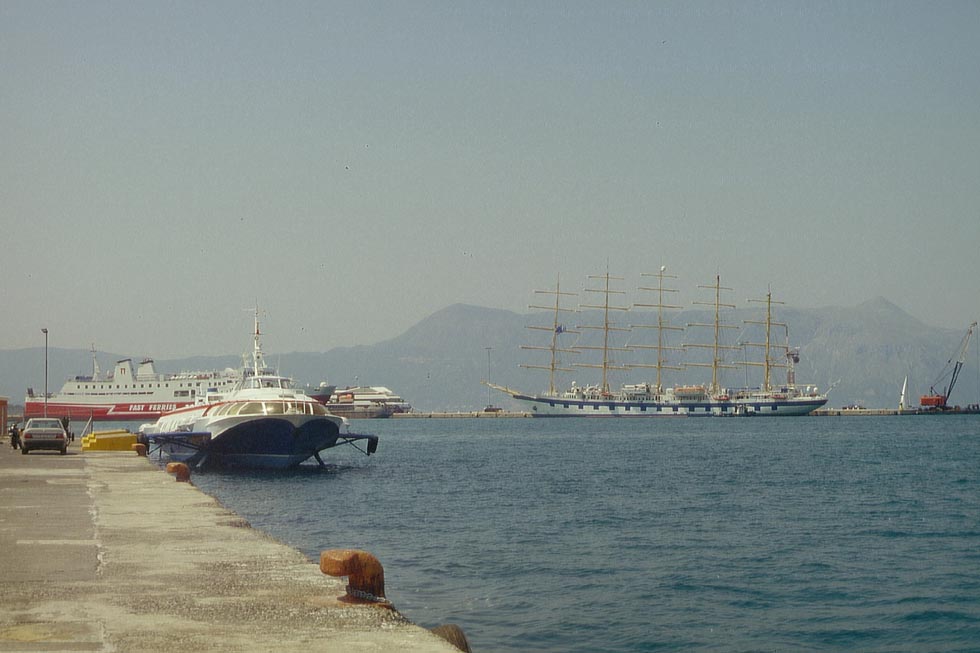
“Star Clipper” and the contrast, a Flying, at Corfu 2006 (WS)
Be in a sailing-boat on the open water and go off-line for a while – that dream becomes true aboard innumerable yachts offered for hire and even for cruises. It’s impossible to list them all. An attempt can be undertaken only to describe some cruise lines under sail with ships of a certain tonnage, of course equipped with auxiliary diesel power. It’s without any prejudice, that renowned companies with smaller ships, such as Windjammer Barefoot Cruises (in 2008 defunct), Peter Deilmann with the “Lili Marleen” (sold in 2004) or Iles du Ponant with “Le Ponant”, which had been attacked by pirates in 2008 off the Somalian coast, are not included in this survey.
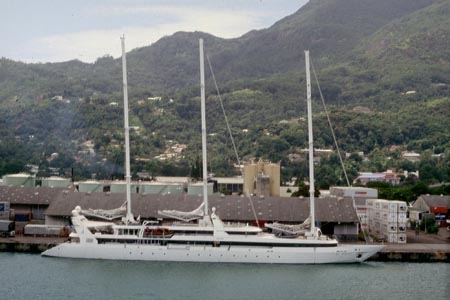 “Le Ponant” at Victoria, Seychelles, 2009 (WS)
“Le Ponant” at Victoria, Seychelles, 2009 (WS)
Sea Cloud Cruises
The most beautiful sailing ship for cruises is for many enthusiasts the “Sea Cloud”. This barque-rigged four-mast vessel had been commissioned as “Hussar” by Wall Street tycoon E.F. Hutton at Krupp-Germania shipyards of Kiel in 1931, to make it a present to his wife Marjorie Merriweather Post. After the couple’s divorce, Mrs. Post relocated the vessel, renamed “Sea Cloud”, to Leningrad in the USSR during Stalin’s time, where her second husband Joseph E. Davies was appointed U.S. ambassador. Aboard the ship remarkable receptions of royalties and diplomats took place and voyages even to the Caribbean were undertaken. During WWII the U.S. Navy used the vessel as a weather station, the masts having been removed. After the end of the war the ship was returned to Mrs. Post. In the ‘50s the “Sea Cloud” was acquired by the Dominican dictator Trujillo, after his overthrow sold to American owners and in 1979 purchased by Hartmut Paschberg together with a group of Hamburg businessmen. The ex-“Hussar”, “Sea Cloud”, “Angelita”, “Patria”, “Antarna” once again was renamed “Sea Cloud”. In the ‘80s the refurbished 2,532-ton “Sea Cloud” started exclusive cruises worldwide with at most some 60, better only 30 passengers on board. Her sail area of 3,000 square metres let her attain a speed of 15 knots. The success of the “Sea Cloud” gave reason to add new clippers.
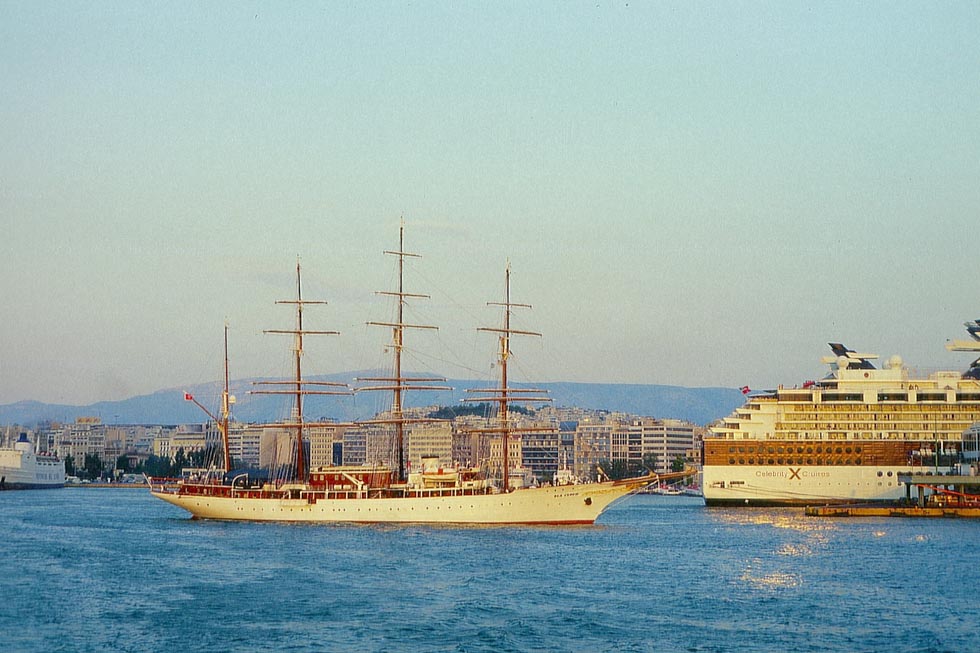
“Sea Cloud”, Piraeus 2005 (WS)
Star Clippers
The Golden Age of clippers was the mid-19th century, when they sailed round Cape Horn from the Atlantic to the Pacific. It was not before 1991 that Mikael Krafft, a Swedish-born industrialist, revived their glory by introducing the four-mast 2,298-ton “Star Flyer” and sister-ship “Star Clipper”, built at SVL Gent, Belgium, modeled on clipper designs of famous 19th-century naval architect Donald McKay. They were cruising so successfully that a third much larger ship was commissioned. This unique fully rigged, five-mast square-sail “Royal Clipper”, inspired by the unforgettable 5,081-ton “Preussen” of almost a century ago (see chapter Historical Review), became the sensation for ship-lovers at every port-of-call. The 4,425-ton “Royal Clipper” was completed in 2000 by Grupa Stozcny shipyard of Gdynia, Poland, using the iron hull of the cruise ship “Gwarek”. The “Royal Clipper”, 134 m long, accommodates 227 passengers and is furnished with a Belle Epoque style three-level atrium. On an Atlantic crossing, the “Royal Clipper” once had only 30 passengers on board, all of them hobby sailors, and they told their stories… When she had a race under sail of together 5,200 square metres against one of her smaller fleet-mates off the coast of the Dominican Republic, she hit around 15 knots. Not enough: Star Clippers planned a 7,400-ton barque-rigged tall ship, 157 m long, accommodating 296 passengers, inspired by the 5,806-ton “France” (II) of 1911, who ran aground in New Caledonia in 1922, her wreck being destroyed by bombers in 1944.
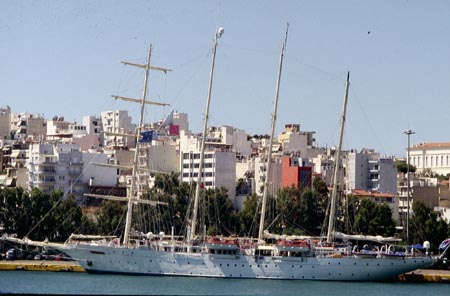 “Star Clipper”, Piraeus 2009 (WS)
“Star Clipper”, Piraeus 2009 (WS)
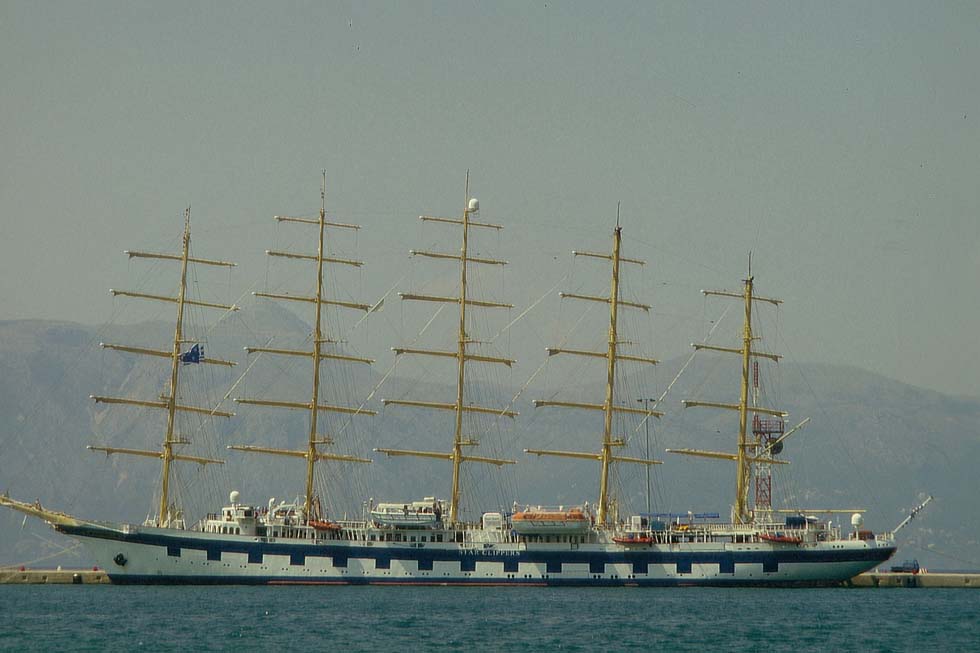
“Royal Clipper”, Corfu 2006 (WS)
Download this picture with 1500 x 1000 pix, 300 dpi

Windstar Cruises
Not pure nostalgia, but an attempt to envision future has led to creation of Windstar Cruises. “The line got its start in 1984, founded by a consortium of two ship-owners and Jean-Claude Potier, a former U.S. head of the legendary French Line. From the start, it was all about the sails – and especially about a new cruise ship design by the Finnish shipbuilding company Wartsila”, reported Frommer’s Cruises & Ports of Call. The schooners of that company, initially Windstar Sail Cruises, are equipped with computer-controlled sails that work at the touch of a button. The ships can sail with or without assistance by their diesel-electric propulsion.
The first among the planned four vessels, contrary to the clipper-style sailing ships classified as wind-assisted propulsion vessels, was the four-mast 5,703-ton “Wind Star”, completed at ACH of Le Havre in 1986. She was followed by the “Wind Song” and “Wind Spirit” of the same type. In 1987 an ad of Windstar Sail Cruises announced South Pacific voyages with a similar four-mast “Wind Surf”. In the same year Holland America Line acquired a 50% share and in 1988 the rest of the company. With acquisition of Holland America by the Carnival Corporation in 1988, Windstar became a subsidiary of that biggest cruise shipping group.
The orders for the “Wind Surf” and “Wind Saga” had passed to Club Med with French government assistance. Windstar Cruises, owned by Carnival, purchased in 1997 one of these Club Med vessels, the “Club Med 1”, a five-mast schooner of 14,745 gt, and renamed her “Wind Surf” for cruises mainly in the Mediterranean and the Caribbean. The smaller “Wind Song” of the first series caught fire at Tahiti in 2002 and was a total loss. Then the intention of acquiring “Club Med 2” was published. In 2008 however, Carnival sold Windstar Cruises.
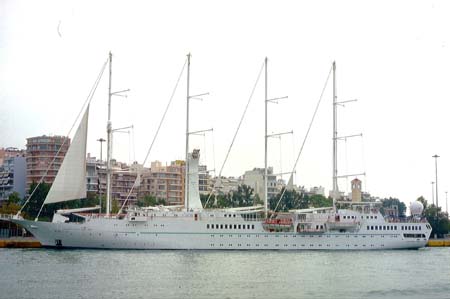
“Wind Star”, Piraeus 2008 (WS)
|
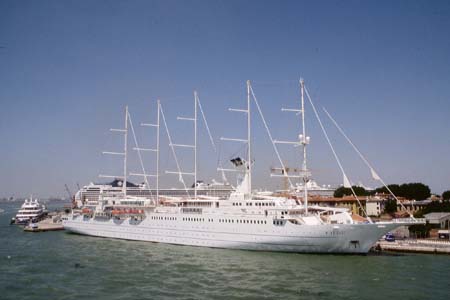
“Wind Surf”, ex “Club Med I”, Venice 2009 (WS)
|
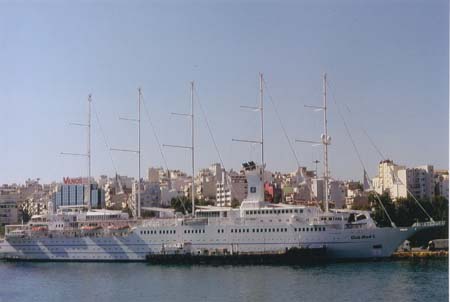
“Club Med 2”, Piraeus 2011 (WS)
|
|
Club Med Cruises
“After having built three of the four sailing ships of the ‘Wind’ series, and now thanks to French capital (Shipowners: Services et Transport, Club Mediterrannee), Ateliers & Chantiers de le Havre have closed the gap by building world’s largest sailing vessel. With a length of 187 m, a beam of 20 m, equipped with 5 iron masts, 66 m high, with 2,500 square metres of sails (…) the ship can accommodate 438 passengers in 202 cabins on 8 decks”, so reported by La Vie du Rail (Jan1990). It’s the above-mentioned “Club Med 1”, a 14,745-ton vessel, which had been launched as “La Fayette” and was completed in 1990. She was followed by her 14,893-ton sister “Club Med 2”, delivered in 1992. With diesel-electric propulsion of 9,720 kW, working on 2 screws, the ships are able to travel at a speed of 15 knots and, under sail only, of more than 12 knots. As described above, “Club Med 1” was sold in 1997 to Windstar Cruises. Ships Monthly reported in April 2007: “There is speculation that Club Med hope to dispose of its only vessel, probably to Windstar Cruises, who already operate her sister-ship as “Wind Surf”. But in the years to follow, she continued cruising for Club Med.
At present, wind-assisted propulsion vessels are outsiders. Will they influence future? Nobody knows. In any case, they have a beauty of their own...
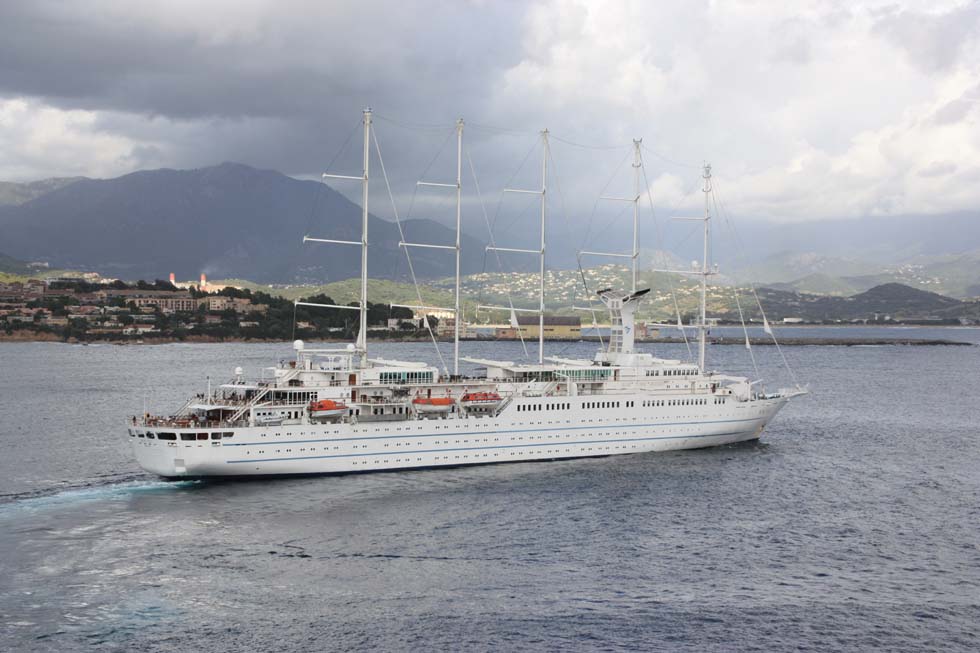
“Wind Surf” of Windstar Cruises, ex “Club Med 1”, at Ajaccio, Corsica 2013 (Anton Soelch)
Download this picture with 1500 x 1000 pix, 300 dpi

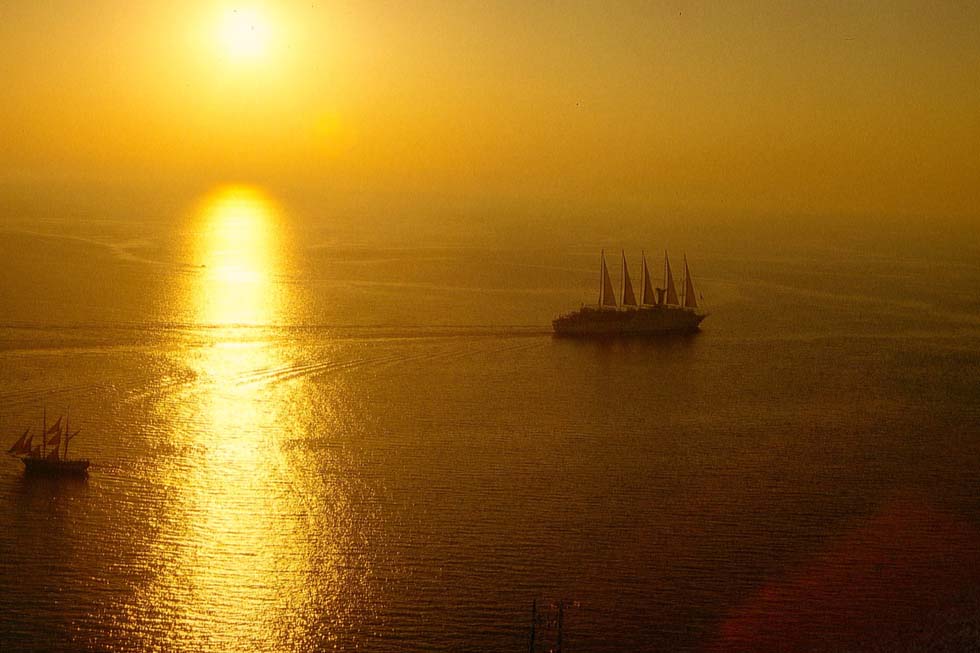
Evening departure from Santorini, 2007 (WS)
|